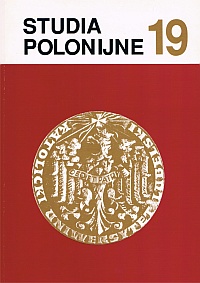The Ukrainian Terror and Crimes against Humankind Committed by OUN-UPA against the Polish Population in Volhynia in the Years 1939-1945
Main Article Content
Abstract
The paper is an introductory summary of the research works on the crimes of OUN-UPA committed in Volhynia in the years 1939-1945. The research material constituted, among other things, of more than 1000 reports of the witnesses of the events, the documents of the District Commission of Investigation Into Crimes Against the Polish Nation in Lublin, the records of legal proceedings in a case to consider as deceased, documents of BIP KG AK and of various cells of AK, the Government's Delegatory at Home, Roman-Catholic parochial registers of the deceased, book and press publications.
The Ukrainian terror against the Polish population, a population that was in the minority in Volhynia (16.6% of the total population in 1931), four stages have been distinguished: the first stage when the Ukrainian attacked in September and October 1939 some selected groups of civilians, small groups and single soldiers of the Polish Army; the second stage, in 1942, raiding parties of OUN attacked single people, mainly those who could play some role in the Polish community; the third stage, in 1943, the so-called Volhynia slaughter in which OUN-UPA committed systematic extermination of the Polish people of Volhynia; the fourth stage, in 1944 and 1945, in which OUN-UPA sought to get rid of the remaining Poles in Volhynia.
We have detailed reports of the slaughter against Poles in 1943. The crimes were committed by the formations of UPA, organized by OUN-UPA Samoobronni Kushtchovi Viddiwy, that is raiding parties mobilized for concrete actions and unassociated Ukrainian peasants. The Poles living in various groups were attacked and murdered with inconceivable cruelty; they were people from villages and purely Polish colonies, ethnically mixed settlements in which Poles made up a numerous group, and, finally, from the Ukrainian places where lived one or a few Polish families. The murdered people were robbed and their farms were burned. Most of them were from villages. Many victims died during escapes or when they moved from place to place with their business.
The Poles, who in the years 1941-1942 were in the minority and were terrorized by the Ukrainian Police and Ukrainians collaborating with them, hand no means to effectively oppose the slaughter. As the rising posts of self-defence had not enough weapon, they were not able to protect people and were usually crushed during attacks on the villages and colonies. Until 1944 only 14 centres of self-defence had survived and this was because they were linked with the partisan groups of the Home Army, which had been established only after the slaughter reached its climax in July 1943.
The estimated losses among the Polish population amounted to 50.000-60.000. The crimes in 1642 places in Volhynia in the total number of places about 3260, where Poles lived, were documented. The crimes in Volhynia make a classic example of genocide on a large scale, according to the Convention for the Prevention and Punishment of the Crimes of Genocide, passed by the General Assembly of UN on 9 December, 1948.

